 |
 |
 |
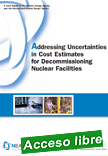 |
State-of-the-Art Report on Molten Corium Concrete Interaction and Ex-Vessel Molten Core Coolability
Nuclear Energy Agency (NEA), 16/10/17, 365 p.
Since 2002, the Nuclear Energy Agency (NEA) has sponsored the Melt Coolability and Concrete Interaction (MCCI) co-operative project in two phases in order to investigate ex-vessel melt coolability and concrete interaction by means of separate-effects tests and large-scale integral tests carried out at the Argonne National Laboratory (ANL). |
The second phase of the experimental programme was completed in March 2010. Key elements of this programme included the conduct of experiments involving real reactor material and associated analyses with the objectives of resolving the ex-vessel debris coolability issues and addressing remaining uncertainties related to long-term twodimensional molten core-concrete interactions under both wet and dry cavity conditions. It was expected that the achievement of these two objectives would demonstrate the efficacy of severe accident management guidelines for existing plants and provide the technical basis for better containment designs for the future plants. During both phases of the programme, a total of 13 separate effects tests were conducted to provide data on various core debris cooling mechanisms, including two specific tests to study mechanisms connected to new design features to enhance coolability by bottom water injection. In addition, six large-scale integral tests were conducted to provide data on long-term two-dimensional core-concrete interaction under both wet and dry cavity conditions and one specific one-dimensional large scale test was conducted to investigate the approach for augmenting ex-vessel corium coolability based on an externally-cooled surface concept. These tests provided a broad database to support the development and validation of models and codes with an aim to assess the behaviour of the full size plants under given conditions.
The Committee on the Safety of Nuclear Installations (CSNI) held a seminar in November 2010 where the major outcomes of the MCCI Project and other complementary experimental activities were presented and discussed.
One of the recommendations of this wrap-up seminar was: “The preparation of a state-of-the-art report on melt coolability and core concrete interactions that captures the last thirty years of international research results”. A consensus was reached to start with the preparation of the recommended report. A proposal was discussed within the framework of the Working Group on Risk Assessment (WGAMA) and endorsed by the CSNI in late 2011.
The mandate and the need for a comprehensive state-of-the-art report (SOAR) can be illustrated by the number of questions raised and discussed during MCCI Project and WGAMA meetings. These questions are: What can be learnt from the experimental data base including the last results of the MCCI Project and complementary national or European projects?; What progress has been made and what is the level of remaining uncertainties on the modelling of corium concrete interaction and molten core coolability?; What could be concluded about the capabilities of the codes to predict corium concrete interaction and molten core coolability with respect to containment integrity assessment in plant application?; What are the remaining issues and opportunities to define further experimental or analytical activities?
Extraído de: http://www.oecd-nea.org/tools/publication?query=&div=&lang=&period=6m&sort=title&filter=1#p7392
|
 |
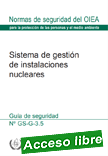 |
Sistema de Gestión de Instalaciones Nucleares
Colección de Normas de Seguridad del OIEA, 2017, 176 p.
El objetivo de esta publicación es dar recomendaciones y orientaciones complementarias de las que figuran en la Referencia (International Atomic Energy Agency, Quality Assurance for Safety in Nuclear Power Plants and other Nuclear Installations, Safety Series No 50-C/SG-Q, OIEA (Vienna), 1996.) |
para instaurar, aplicar, evaluar y mejorar constantemente un sistema de gestión que integre elementos correspondientes a la seguridad tecnológica, la salud, el medio ambiente, la seguridad física, la calidad y la economía. Todos los temas tratados corresponden a los requisitos establecidos en la Referencia.
Extraído de: http://www-pub.iaea.org/MTCD/Publications/PDF/P1392_S_web.pdf
Extraído de: http://www-pub.iaea.org/books/IAEABooks/10666/The-Management-System-for-Nuclear-Installations |
 |
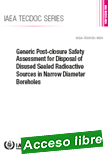 |
Generic Post-closure Safety Assessment for Disposal of Disused Sealed Radioactive Sources in Narrow Diameter Boreholes
IAEA TECDOC, 2017, 320 p.
The objective of this TECDOC is to document a generic safety assessment (GSA) for this borehole disposal concept, with the purpose of identifying the concept’s key safety features, under varying disposal system conditions,
|
in order to support the concept design and licensing processes, and facilitate its site specific implementation.
Extraído de: http://www-pub.iaea.org/MTCD/Publications/PDF/TE-1824_web.pdf
Extraído de: http://www-pub.iaea.org/books/IAEABooks/12263/Generic-Post-closure-Safety-Assessment-for-Disposal-of-Disused-Sealed-Radioactive-Sources-in-Narrow-Diameter-Boreholes
|
 |
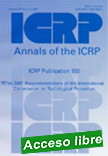 |
The Commission defines a set of operational dose quantities for the determination of the exposure of external radiation by measurement or calculation.
|
These assessments serve as estimates of values of the protection quantities defined by the International Commission on Radiological Protection (ICRP) that are generally not measurable. The set of ICRU operational dose quantities in current use was defined 30 years ago. The rationale for operational quantities has been examined taking into account the recent changes in the definitions of the protection quantities (ICRP, 2010); the changes in the fields of application of the operational quantities and protection quantities in medicine, scientific research, and natural sources of radiation; and the extension of types of particles and range of energies contributing to doses to workers and members of the public. The previous operational quantities were based on the dose equivalent that would be produced at a depth in the hypothetical ICRU 4-element sphere, and on dose equivalent in soft tissue at a point in the body. The investigations which have been carried out that have led to the recommendations given in this Report have included the study the values of weighted absorbed doses at different depths in tissue-equivalent phantoms and the combination of different depths. The operational quantities recommended in this Report are defined in terms of radiometric and dosimetric quantities at a point in space multiplied by values of conversion coefficients to the protection quantities, effective dose, absorbed dose in the lens of the eye, and absorbed dose in local skin, calculated for broad parallel beams incident on the body. The relationship of the recommended operational quantities to the protection quantities has been investigated. The impact of changes on routine measurement practice, including instrument design and calibration has been considered.
Extraído de: http://www.icrp.org/page.asp?id=355
|
 |
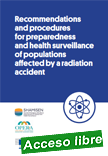 |
Recommendations and procedures for preparedness and health surveillance of populations affected by a radiation accident
Shamisen Project (European Commission funded), 2017, 54 p.
The EU-OPERRA SHAMISEN project started in December 2015, with the goal of
producing a set of recommendations that would contribute to health surveillance
and related communication with affected populations after nuclear accidents. |
Experience suggested that this was an area that had not been sufficiently addressed in current accident response planning in many European countries. It was also recognised that an update of emergency preparedness in this area was needed for a number of reasons. These include the fact that existing recommendations had a technical focus, with less attention paid to social, ethical, psychological issues and that the information tended to be directed towards the decisions made by experts rather than for support of affected populations. Finally, there have been a number of changes in legal and ethical requirements for health surveillance and epidemiological studies (e.g., related to data protection) that need consideration.
Extraído de: http://www.irsn.fr/FR/Actualites_presse/Actualites/Documents/IRSN_Shamisen-recommendation-guide_201709.pdf
|
 |

|
IAEA-RML-2015-01 Proficiency Test for Determination of Radionuclides in Sea Water
IAEA Analytical Quality in Nuclear Applications Series, 2017, 72 p.
The IAEA Environment Laboratories (IAEA-EL) in Monaco and Seibersdorf regularly organize proficiency tests (PT) for radionuclides in environmental samples to support laboratories in IAEA Member States. |
The organization and the results of a second PT organized in cooperation with the Nuclear Regulation Authority (NRA) in Japan are described in this publication. Nine laboratorios associated with the IAEA Technical Cooperation project RCA RAS/7/021 entitled ‘Marine Benchmark Study on the Possible Impact of the Fukushima Radioactive Releases in the Asia-Pacific Region’ also took part in the exercise.
Extraído de: http://www-pub.iaea.org/MTCD/Publications/PDF/AQ-51_web.pdf
|
 |
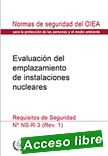 |
Evaluación del emplazamiento de instalaciones nucleares
Colección de normas de seguridad del OIEA, 2017, 29 p.
El objetivo de esta publicación es establecer los requisitos de los elementos de la evaluación del emplazamiento de una instalación nuclear, con el fin de caracterizar exhaustivamente las condiciones específicas del emplazamiento que revisten interés para la seguridad de la instalación nuclear.
|
Se pretende establecer los requisitos para los criterios que deben aplicarse según corresponda al emplazamiento y a sus interacciones con la instalación en los estados operacionales y en condiciones de accidente, incluidas las interacciones que podrían dar lugar a condiciones que requieran medidas de respuesta a emergencias con miras a: a) definir el alcance de la información sobre el emplazamiento propuesto que debe presentar el solicitante; b) evaluar el emplazamiento propuesto para asegurar que se tienen debidamente en cuenta los fenómenos y las características afines al emplazamiento; c) analizar las características de la población de la región y la capacidad para ejecutar planes de emergencia durante la vida útil prevista de la instalación; d) definir los peligros relacionados con el emplazamiento.
Esta publicación no aborda de manera concreta las instalaciones subterráneas o frente a la costa.
Extraído de: http://www-pub.iaea.org/books/IAEABooks/11037/Site-Evaluation-for-Nuclear-Installations |
 |
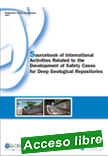 |
Sourcebook of International Activities Related to the Development of Safety Cases for Deep Geological Repositories
Nuclear Energy Agency (NEA), 21/08/17, 64 p.
All national radioactive waste management authorities recognise today that a robust safety case is essential in developing disposal facilities for radioactive waste. |
To improve the robustness of the safety case for the development of a deep geological repository, a wide variety of activities have been carried out by national programmes and international organisations over the past years. The Nuclear Energy Agency, since first introducing the modern concept of the ?safety case?, has continued to monitor major developments in safety case activities at the international level. This Sourcebook summarises the activities being undertaken by the Nuclear Energy Agency, the European Commission and the International Atomic Energy Agency concerning the safety case for the operational and post-closure phases of geological repositories for radioactive waste that ranges from low-level to high-level waste and for spent fuel. In doing so, it highlights important differences in focus among the three organisations.
Extraído de: http://www.oecd-nea.org/tools/publication?query=&div=&lang=&period=6m&sort=title&filter=1#p7341
|
 |
|
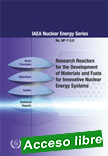
|
Research Reactors for the Development of Materials and Fuels for Innovative Nuclear Energy Systems
IAEA Nuclear Energy Series, 2017, 27 p.
This publication presents an overview of research reactor capabilities and capacities in the development of fuels and materials for innovative nuclear reactors, such as GenIV reactors. The compendium provides comprehensive information on the potential for materials and fuel testing research of 30 research reactors, both operational and in development.
|
This information includes their power levels, mode of operation, current status, availability and historical overview of their utilization. A summary of these capabilities and capacities is presented in the overview tables of section 6. Papers providing a technical description of the research reactors, including their specific features for utilization are collected as profiles on a CD-ROM and represent an integral part of this publication. The publication is intended to foster wider access to information on existing research reactors with capacity for advanced material testing research and thus ensure their increased utilization in this particular domain. It is expected that it can also serve as a supporting tool for the establishment of regional and international networking through research reactor coalitions and IAEA designated international centres based on research reactors.
Extraído de: http://www-pub.iaea.org/books/IAEABooks/10984/Research-Reactors-for-the-Development-of-Materials-and-Fuels-for-Innovative-Nuclear-Energy-Systems
|
 |
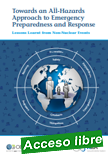 |
Towards an All-Hazards Approach to Emergency Preparedness and Response Prevention Mitigation Safety Preparedness Guidance Response Emergency Recovery - Lessons Learnt from Non-Nuclear Events
Nuclear Energy Agency (NEA), 2018, 104 p.
Over the years, member countries from the OECD Nuclear Energy Agency (NEA) have developed effective emergency preparedness and response (EPR) arrangements for nuclear facilities and off-site response organisations.
|
These arrangements have usually been tested through exercises involving the facility and off-site response organisations.
EPR arrangements have thus been enhanced as necessary to include lessons learnt from nuclear emergency exercises, nuclear power plant accidents such as the accident at Fukushima Daiichi and changes to international guidance.
While nuclear power plant accidents are very rare, industrial non-nuclear events and natural disasters occur more frequently and can have a potentially large impact on populations and on widespread geographical areas. As a result of these events, populations may be required to take part in protective actions such as sheltering, evacuation and the restriction of food supplies. Research on these types of non-nuclear events and natural disasters has been extensive and has led to an understanding of factors that have supported the effectiveness of response activities, as well as those factors that may have degraded the response. This type of information can be used to enhance existing preparedness efforts for nuclear power plants, for other industrial facilities and for natural disasters in an “all-hazards” framework. In recognition of the importance of an all-hazards approach to preparedness and
response, the International Atomic Energy Agency (IAEA) General Safety Requirements (GSR No. 7), Preparedness and Response for a Nuclear or Radiological Emergency (IAEA, 2015), encourage, to the extent practicable, the inclusion of the emergency management system in an all-hazards framework. The OECD Council similarly supports the integration of a nuclear emergency management system into a comprehensive, all-hazards and transboundary approach to country risk governance as a foundation for enhancing national
resilience and responsiveness. Contributions to this report support the value of such an allhazards approach to EPR.
Extraído de: https://www.oecd-nea.org/rp/pubs/2018/7308-all-hazards-epr.pdf
|
 |
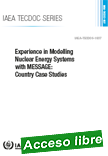 |
Experience in Modelling Nuclear Energy Systems with MESSAGE: Country Case Studies
IAEA TECDOC, 2018, 280 p.
Member States have recognized the increasing need to model future nuclear power scenarios in order to develop strategies for sustainable nuclear energy systems. The IAEA model for energy supply strategy alternatives and their general environmental impacts (MESSAGE) code is a tool that supports energy analysis and planning in Member States.
|
This publication documents the experience gained on modelling and scenario analysis of nuclear energy systems (NES) using the MESSAGE code through various case studies performed by the participating Member States on evaluation and planning for nuclear energy sustainability at the regional or national level. The publication also elaborates on experience gained in modelling of global nuclear energy systems with a focus on specific aspects of collaboration among technology holder and technology user countries and the introduction of innovative nuclear technologies. It presents country case studies covering a variety of nuclear energy systems based on a once-through fuel cycle and a closed fuel cycle for thermal reactors, fast reactors and advanced systems. The feedback from case studies proves the analytical capabilities of the MESSAGE model and highlight the path forward for further advancements in the MESSAGE code and NES modelling.
Extraído de:http://www-pub.iaea.org/books/IAEABooks/12295/Experience-in-Modelling-Nuclear-Energy-Systems-with-MESSAGE-Country-Case-Studies
|

|
|
|
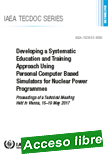 |
Developing a Systematic Education and Training Approach Using Personal Computer Based Simulators for Nuclear Power Programmes - Proceedings of a Technical Meeting Held in Vienna, 15–19 May 2017
IAEA TECDOC, 2018, 164 p.
This publication compiles the output and findings of a technical meeting organized by the IAEA. The use of personal computer (PC) based basic principle simulators in education and training is aimed at enhancing understanding of nuclear technologies through “learning by doing”.
|
This hands-on experiential training is highly suitable for operators, maintenance technicians, suppliers, regulators, students and engineers. Experts from 21 Member States, together with IAEA staff, presented the current status of the PC based basic principle simulators, their applications in education and training and identified relevant gaps and needs for improvements and/or new development. The resultant publication includes summaries of the presentations, follow-up discussions as well as conclusions and recommendations for possible future activities.
Extraído de:http://www-pub.iaea.org/books/IAEABooks/12301/Developing-a-Systematic-Education-and-Training-Approach-Using-Personal-Computer-Based-Simulators-for-Nuclear-Power-Programmes
|
| |
| |
|
|
| |
| |
|
|
| |
| |
|
|
|
